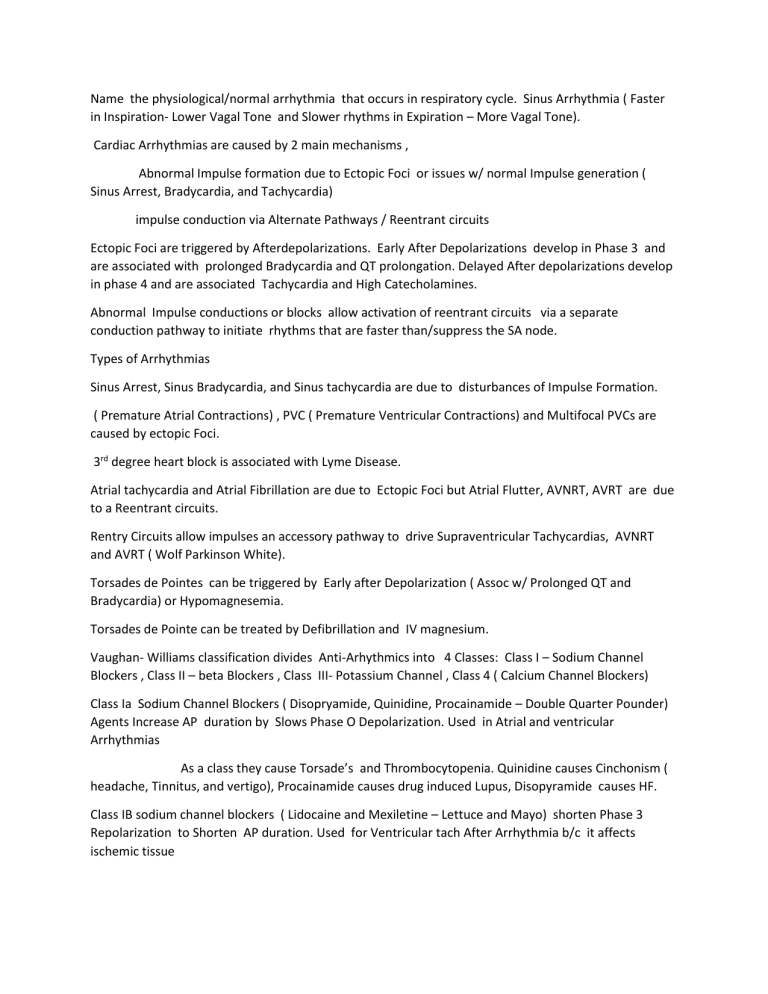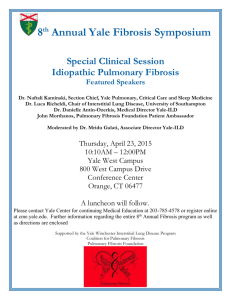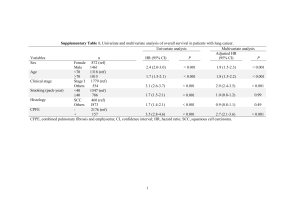Arrhythmics
advertisement

Name the physiological/normal arrhythmia that occurs in respiratory cycle. Sinus Arrhythmia ( Faster in Inspiration- Lower Vagal Tone and Slower rhythms in Expiration – More Vagal Tone). Cardiac Arrhythmias are caused by 2 main mechanisms , Abnormal Impulse formation due to Ectopic Foci or issues w/ normal Impulse generation ( Sinus Arrest, Bradycardia, and Tachycardia) impulse conduction via Alternate Pathways / Reentrant circuits Ectopic Foci are triggered by Afterdepolarizations. Early After Depolarizations develop in Phase 3 and are associated with prolonged Bradycardia and QT prolongation. Delayed After depolarizations develop in phase 4 and are associated Tachycardia and High Catecholamines. Abnormal Impulse conductions or blocks allow activation of reentrant circuits via a separate conduction pathway to initiate rhythms that are faster than/suppress the SA node. Types of Arrhythmias Sinus Arrest, Sinus Bradycardia, and Sinus tachycardia are due to disturbances of Impulse Formation. ( Premature Atrial Contractions) , PVC ( Premature Ventricular Contractions) and Multifocal PVCs are caused by ectopic Foci. 3rd degree heart block is associated with Lyme Disease. Atrial tachycardia and Atrial Fibrillation are due to Ectopic Foci but Atrial Flutter, AVNRT, AVRT are due to a Reentrant circuits. Rentry Circuits allow impulses an accessory pathway to drive Supraventricular Tachycardias, AVNRT and AVRT ( Wolf Parkinson White). Torsades de Pointes can be triggered by Early after Depolarization ( Assoc w/ Prolonged QT and Bradycardia) or Hypomagnesemia. Torsades de Pointe can be treated by Defibrillation and IV magnesium. Vaughan- Williams classification divides Anti-Arhythmics into 4 Classes: Class I – Sodium Channel Blockers , Class II – beta Blockers , Class III- Potassium Channel , Class 4 ( Calcium Channel Blockers) Class Ia Sodium Channel Blockers ( Disopryamide, Quinidine, Procainamide – Double Quarter Pounder) Agents Increase AP duration by Slows Phase O Depolarization. Used in Atrial and ventricular Arrhythmias As a class they cause Torsade’s and Thrombocytopenia. Quinidine causes Cinchonism ( headache, Tinnitus, and vertigo), Procainamide causes drug induced Lupus, Disopyramide causes HF. Class IB sodium channel blockers ( Lidocaine and Mexiletine – Lettuce and Mayo) shorten Phase 3 Repolarization to Shorten AP duration. Used for Ventricular tach After Arrhythmia b/c it affects ischemic tissue Class IC sodium Blockers ( Flecainamide and Propafenone- Fries Please ) has no effect on AP duration. Do not use ischemic Disease. Use only in structurally normal hearts Class II Betablockers are used for PVCs, SVT, AFib , and A. Flutter but have the side effect of impotence and Bronchospasm. Class III Potassium channel blockers ( Amiodarone) Increase ERP but Blocks other channels too ( Dirty Drug. Amiodarone has 3 side effects : Pulmonary Fibrosis, Hepatotoxicity, and Thyroid Dysfunction. Monitor PFT, LFT, TFT. Class IV agents ( Diltiazem, verapamil) block L-type channels and are contraindicated in HF and Heartblocks. Adenosine activates AV node K+ Channels leading to Hyperpolarization. It is an Unpleasant drug w/ SFx Bronchospasm, Chest tightness, and Sense of doom. Digoxin Blocks Na/K ATPase and increases Inotropy. Considarations for Usage include Narrow TI/Drug Interactions and Visual changes Obstructive Lung Dz, Pneumoconioses, Pulmonary HTN Obstructive Lung Diseases show Decreased FEV/FVC ratio on Spirometry, increased TLC/RV due to Air trapping, and V-Q mismatch . Chronic bronchitis (Blue Bloaters) and Emphysema ( Pink Puffers) are two lung diseases in the COPD category. Define Chronic Bronchitis: chronic, productive cough lasting more than half of the time over a minimum of 2 yrs Chronic Bronchitis pathogenesis is Hypertrophy/ hyperplasia of bronchial mucinous glands leading to increased thickness of mucus glands relative to the thickness of the bronchial wall (Reid index) Chronic bronchitis patients present with productive cough, Hypoxia/Cyanosis ( Blue Bloater), and Increased PVR that can lead to Pulmonary HTN. Emphysema pathogenesis is due to protease/ anti-protease imbalance where excess protease activity destroys alveolar walls decreasing elasticity and increasing compliance. Smoking causes Centri-Acinar Emphysema while are Pan-acinar Emphysema and Liver Cirrhosis caused by alpha 1 anti-trypsin deficiency. On Histopath, Emphysema patients will show dilated Air Sacks( No Fibrosis) and Alveoli with loss of elasticity on Gross path. Emphysema patients present with Pursed Lip-Breathing,( Pink Puffers) , Barrel Chest and clubbed fingers . Asthma is a reversible airway bronchoconstriction due to IgE hypersensitivity with Mast cell release of Histamine and Leukotrienes. Treated with beta agonists. Histological changes in Asthma are Spiral Mucus plugs (Curschmann Spirals) in Terminal bronchioles and thickened BM and SM Hypertrophy in bronchi. Bronchiectasis is a permanent dilation of bronchi/bronchioles after infection/ inflammation mainly associated by Cystic Fibrosis and Cililary Dyskinesis. Penumoconioses are non- neoplastic rxn to Mineral dust inhalation ( occupational). 3 common types of Coal Workers Pneumoconiosis, Silicosis, and Asbestosis. - - - Coal workers (CWP) o Simple CWP can cause Centriolobular distruction with a Benign clinical course. o Complicated CWP- years of coal W/ Silica leads to fibrosis and scarring and development of pulmonary HTN &cor pulmonale Silicosis –Inhalation of Silica can present acutely as Alveolar protinosis, chronically as Diffuse Inetrsitioal Fibrosis and over manu years as Calcified silicotic nodules along pleura and Hilar Lymph nodes. o Pathogenesis of Silicosis: Macrophages phagocytize silical and release fibrogenic cytokines. o On Biopsy in Silicosis, One would note Birefrigent Needle Shaped particles on Polarized Microscopy. o Occupational Exposure for Silicosis : sand blasting . Sandblasters are at increased risk for Tuberculosis Infection ( Associated with Silicosis) Increase risk for developing TB due to imparment in macrophages - - Asbestos o Benign plural disease- rounded atelectasis – can resemble lung cancer o How is Asbestosis differentiated from UIP/IPF – presence of asbestos bodies to differentiate from UIP o Asbestos bodies are coated Asbestos fibers inside macrophages. o Asbestosis is associated with Lung carcinoma and Lalignant Mesotheloima o Types of fibers – serpentine vs amphibole (higher freq with mesothelioma and carcinoma) o Pleural plaque – indicates significan exposure compared to gen population Pathogenesis of common pnemo Beryllosis – Presents with Sarcoidosis like non necrotizing granulomas and is differentiated with beryllium lymphocyte proliferation test (positive for Ber) o Exposure – industrial work background, (golf clubs made form beryllium) Pulmonary HTN ● Define Pulmonary Hypertension high pressure in pulmonary circulation (MAP >25 mmHg) ○ Normally, pressure is ~10 mmHg Primary (Idiopathic) Pulmonary HTN is Usually young, adult females and associated with inactivating mutation of BMPR2 protein*** which Leads to excess proliferation of vascular SM Secondary Pulmonary HTN ● Due to hypoxemia and cardiac disease recurrent pulmonary embolism Pathology ● Medial Hypertrophy that leads to Intimal Fibrosis . Long standing PULM hypertension presentis with plexiform lesions (clustering of capillaries):



